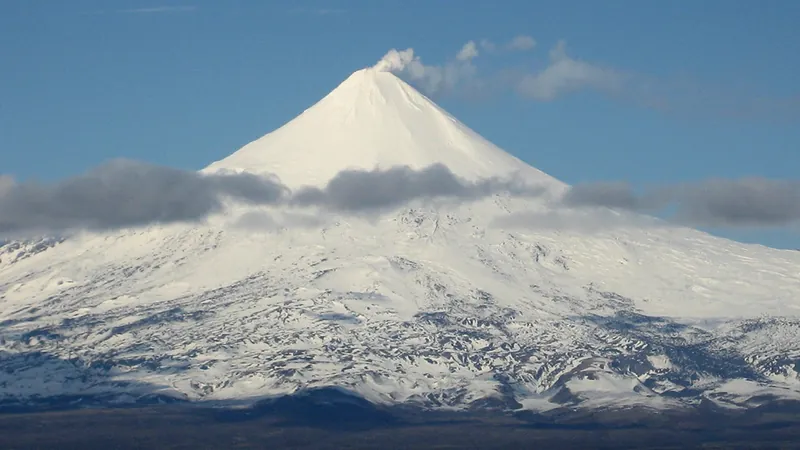
Alarming Insights from Antarctic Ice: What Do Recent CO2 Jumps Reveal About Climate Change?
2024-11-14
Author: Sophie
Introduction
The Earth's atmosphere is in a state of constant flux. Its composition has shifted throughout various climatic epochs, particularly about carbon dioxide (CO2) levels—an essential element influencing global climate patterns.
Significant CO2 Research Findings
Recent research published in *Nature Geoscience* sheds light on significant findings regarding recent increases, or "jumps," in atmospheric CO2 concentrations. These jumps indicate spikes of about 10 parts per million (ppm) occurring within a century, a rate that, although notable, is dwarfed by the more drastic increases stemming from human activity.
The study of ancient air bubbles trapped within Antarctic ice cores has allowed scientists to reconstruct atmospheric CO2 variations over the last 500,000 years. Remarkably, it was found that the majority of these CO2 jumps happened during periods of high obliquity, when the Earth's tilt in relation to the sun was greater than usual. Presently, we are also in a phase of high obliquity.
What Constitutes CO2 'Jumps'?
The atmospheric CO2 jumps referenced are defined by their swift increases—about 10 ppm over the span of just a century—over the last 500,000 years. While such leaps are significant, they remain, on average, 10 to 20 times smaller than the surges caused by human activity. For context, the last 100 years have seen a CO2 increase of approximately 115 ppm, marking ten times the size of historical jumps.
The detailed analysis involved extracting an ice core—a cylindrical sample of ice approximately 10 centimeters in diameter, drilled several kilometers deep into Antarctica. This research identified seven new CO2 jumps from the period between 260,000 and 190,000 BC, in addition to 15 previously documented jumps. Crucially, 18 out of 22 jumps studied occurred during periods of higher obliquity.
The Interplay of Climate Factors
These sudden CO2 jumps are not random; they are the result of a complex interplay of phenomena. The primary driver appears to be disruptions in the AMOC, which influences global climate conditions. However, not every AMOC disruption leads to a CO2 spike—it is only when combined with periods of heightened obliquity that we see such effects manifest.
Earth's obliquity, which oscillates between approximately 22° and 25° in cycles lasting about 41,000 years, affects how solar energy is distributed across the planet. This in turn impacts various regional climates and biodiversity, particularly influencing vegetation that plays a crucial role in carbon storage. As vegetation changes in response to these climatic shifts, it can release previously stored CO2 back into the atmosphere when AMOC is disrupted.
A Double Threat to Our Climate
With our current tilt indicating a high obliquity, alarming scenarios emerge. If a significant slowdown of the AMOC were to occur, it could lead to the release of carbon equivalent to four years' worth of global emissions within a few decades, significantly exacerbating the effects of human-induced climate change.
However, modeling the AMOC remains fraught with uncertainty. Some predictions indicate that human-caused climate change might be behind the slow down of this ocean current. Should the AMOC collapse, we could witness new surges in CO2 emissions from natural sources that have been destabilized, essentially creating a feedback loop that intensifies ongoing climate issues.
Conclusion: The Call to Action
These findings underline the urgent need for a comprehensive understanding of our climate mechanisms and the factors influencing them. The potential for natural CO2 jumps due to oceanic and tilt dynamics alongside anthropogenic emissions raises critical questions about our planet’s future. As we stand at the crossroads of climate awareness and action, understanding these intricate relationships might be crucial in crafting effective strategies to combat global warming. The time to act is now—our climate’s stability depends on it!









 Brasil (PT)
Brasil (PT)
 Canada (EN)
Canada (EN)
 Chile (ES)
Chile (ES)
 España (ES)
España (ES)
 France (FR)
France (FR)
 Hong Kong (EN)
Hong Kong (EN)
 Italia (IT)
Italia (IT)
 日本 (JA)
日本 (JA)
 Magyarország (HU)
Magyarország (HU)
 Norge (NO)
Norge (NO)
 Polska (PL)
Polska (PL)
 Schweiz (DE)
Schweiz (DE)
 Singapore (EN)
Singapore (EN)
 Sverige (SV)
Sverige (SV)
 Suomi (FI)
Suomi (FI)
 Türkiye (TR)
Türkiye (TR)